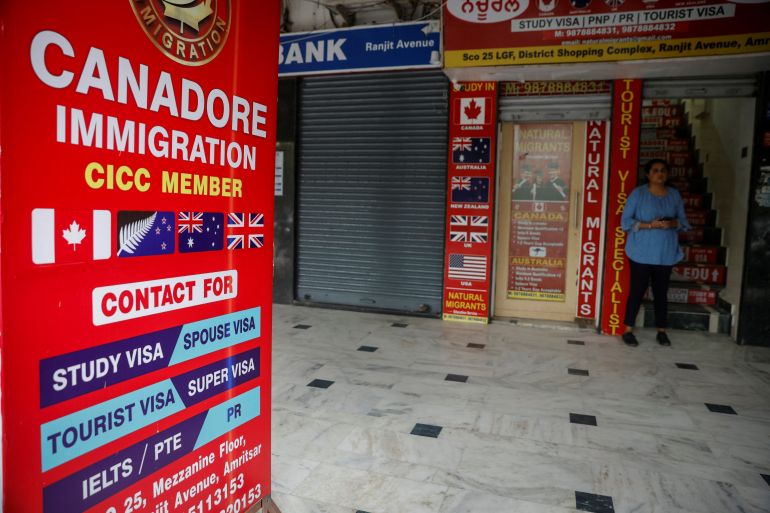Canada to reduce new immigration by 21 percent
The immigration controls will limit the country to 1.1 million newcomers from 2025 to 2027.
A girl stands outside an immigration consultant office at a market in Amritsar in the northern Indian state of Punjab [File: Adnan Abidi/Reuters]Published On 24 Oct 202424 Oct 2024
Canada has announced it will slash immigration for the first time in years, a major policy shift for the government as it tries to remain in power.
From 2025 to 2027, Canada will bring in a total of 1.1 million new permanent residents, a 21 percent drop from previous years, the government announced on Thursday.
The number of temporary residents, meanwhile, will also decrease by about 30,000 to 300,000 in 2025, Immigration Minister Marc Miller said.
The government said the plan “will pause population growth in the short term to achieve well-managed, sustainable growth in the long term”.
Canadian Minister of Immigration, Refugees and Citizenship Marc Miller speaks in the House of Commons on Parliament Hill in Ottawa, Canada [File: Blair Gable/Reuters]
‘We didn’t get the balance right’
The new immigration targets represent a break from the COVID-19 pandemic era when the government eased restrictions on temporary residents to fill labour shortages.
Last year, Canada had planned to bring in 500,000 new permanent residents in 2025 and the same amount in 2026. As of the second quarter of 2024, there were 2.8 million temporary residents, including workers and students, in Canada, according to Statistics Canada.
The government statement suggested the country’s post-pandemic needs had evolved after immigrants had met business demands to aid the economic recovery and as they put pressure on housing, infrastructure and social services.
“Today’s announcement is the next step in our plan to address the evolving immigration needs of our country,” Miller said. “While it’s clear our economy needs newcomers, we see the pressures facing our country, and we must adapt our policies accordingly.”
“We didn’t get the balance quite right,” Prime Minister Justin Trudeau said of the change in policy.
The new plan will bring in 395,000 new permanent residents in 2025, 380,000 in 2026 and 365,000 in 2027, down from 485,000 in 2024.
Trudeau has lately faced pressure to step down amid slumping poll numbers and the rise in support for the opposition Conservatives.
Canadian Prime Minister Justin Trudeau has rebuffed pressure to resign as his disapproval ratings rise, saying he has ‘important work to do’ [Blair Gable/Reuters]
‘Assault on migrants’
Canada has long prided itself on welcoming newcomers, but in recent years, the national debate around immigration has shifted in part due to rising housing prices, the Reuters news agency reported.
Many Canadians have been priced out of the housing market since interest rates started rising two years ago. At the same time, a huge influx of immigrants has pushed Canada’s population to record levels, further boosting housing demand and prices.
The issue has become one of the most contentious in Canadian politics with a federal election due no later than October 2025 and its Liberal government trailing in the polls. Public surveys showed a growing share of the population thinks Canada has too many immigrants.
There has been a backlash against newcomers and more reported hate crimes against minorities, advocates and community members say.
Immigrant advocates slammed the change.
“We are witnessing one of the most egregious rollbacks of migrant rights in Canadian history,” Syed Hussan, spokesperson for the Migrant Rights Network Secretariat, said in a statement. “Cutting permanent resident numbers is a direct assault on migrants, who will be forced to remain temporary or become undocumented, pushed further into exploitative jobs.”
Canada’s three-year immigration controls are projected to cause its population to decline by a marginal 0.2 percent in both 2025 and 2026. The next year, population is expected to shoot back up by 0.8 percent, according to the government.
“These changes will help provinces, territories and stakeholders align their capacities and allow the population to grow at a sustainable pace as we encourage institutions to do their part in better welcoming newcomers,” the government said.
